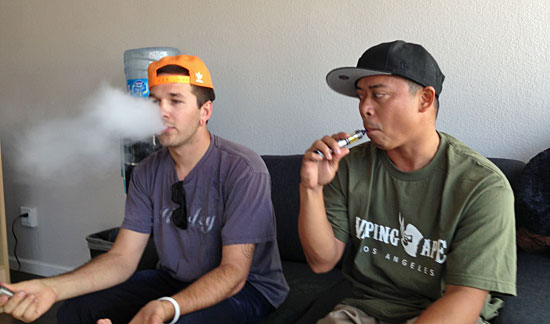Getting fired up over e-cigarettes
July 11, 2013
These days, e-cigarettes are smokin’ hot.
That guy sitting next to you in traffic, puffing on a pipe-like cylinder as clouds of vapor billow around his head, isn’t getting high—he’s ‘vaping.’
“Vape shops” are suddenly everywhere, some of them offering a lounge-style atmosphere for firing up and partaking of hundreds of flavor options—ranging from AppleCinnana to Yummy Gummy—for the nicotine-infused “e-juice” that creates vapor and delivers an adjustable dose of nicotine.
Big Tobacco is getting in on the act, too, with the makers of Marlboro and Camel preparing to sell their own brands of e-cigarettes, and the company that produces Newports buying the e-cig brand Blu.
But where there’s vape, there’s worry. Even though e-cig users contend that vaping helps reduce or eliminate their craving for dangerous regular smokes, public health experts, government officials and anti-smoking groups say it’s way too soon to assume the new devices are safe. E-cigs, they say, pose potential health hazards for smokers and those around them, and more study is needed to establish the risks.
“It is alarming that we’re seeing so many of these,” said Linda Aragon, director of the county’s Tobacco Control and Prevention Program. “You see a lot more of these vaping stores, or even vapor lounges that are popping up all over the place. We’re seeing much more of that than we have in the past.”

Marketing campaigns include bringing in Playboy's Miss November, Brittany Nola, for an e-cig launch party in New York.
Nicotine is, of course, highly addictive, and there are concerns that e-cigarettes’ kid-friendly flavor palette could attract underage smokers, or even pose an overdose hazard, particularly for small children who happen upon one of the “e-juice” flavor canisters. Researchers have found that propylene glycol, one of the main ingredients in the liquid, can be an irritant when inhaled. Concerns also have been raised about what happens when an array of potentially harmful substances found in some e-cigarettes are vaporized and inhaled by e-smokers and bystanders.
Los Angeles County, acting on motions by Supervisor Zev Yaroslavsky, has banned traditional cigarette smoking on beaches and in county parks, and requires tobacco retailers in unincorporated areas to be licensed. But it has not yet taken steps to regulate e-cigarettes, which can legally be sold in California to customers 18 years of age or older. The state Senate recently approved a bill by Senate Majority Leader Ellen Corbett that would make e-cigs subject to California’s smoke-free laws and ban their use in workplaces, public buildings and other locations that currently prohibit smoking. That bill is working its way through the Assembly and could reach Gov. Jerry Brown by this fall.
“We’ve worked hard to protect the public’s health by banning smoking in places where non-smokers would be adversely impacted,” Yaroslavsky said. “This new trend is a giant step backward from those efforts. Hopefully, the state legislature and the governor will solve that problem before the summer is over.”
Some municipalities around the state also are scrambling to impose e-cig restrictions, ranging from banning their use in public buildings to imposing a moratorium on new vape stores.
Starbucks has cracked down, too, banning e-cigs—along with the traditional kind—in its outdoor seating areas as of this June 1. And the issue’s gone global, with the World Health Organization this week joining the chorus of those urging caution in the use of what it terms “electronic nicotine delivery systems.”
Such warnings come against a backdrop of surging e-cig use. The federal Centers for Disease Control and Prevention reported that 21% of cigarette smokers have tried the electronic version, up from 10% in 2010.
The U.S. Food and Drug Administration says that consumers should not assume e-cigarettes are safe until more testing is done. In 2010, the FDA issued warning letters to five manufacturers for violations including “unsubstantiated claims and poor manufacturing practices.”
Vapers often say that e-cigs have made it easier for them to cut down on regular cigarettes or even to kick the habit altogether.
Aragon, of the county’s tobacco control program, doesn’t buy it.
“The reality is that there haven’t been enough studies to show that there is a sustained ‘quit,’ ” she said. “Our position is that folks who are trying to quit smoking should always use FDA-approved cessation resources, like nicotine patches, nicotine gum, Wellbutrin.”
Greg Simidy, a 21-year-old student who lives in Los Feliz, recently started vaping and said it enabled him to quit regular cigarettes “cold turkey.”
“I got into it with the intention of quitting smoking,” Simidy said, adding that he also “got into it because I saw everyone was doing it.”
On a sunny late morning this week, he was in a newly opened Hollywood store, Vaping Ape, looking to upgrade his equipment. “I want something that gives me the smoke, that feels better in the hand,” he said. And with the availability of tasty flavors like his current favorite, banana nut bread, he sees no reason to turn back.
“I think [cigarette] smoking is a thing of the past, to be honest,” he said.
One of the store’s owners, Jake Bautista, said his customers range from 18-year-olds to “a couple from Burbank in their mid-60s. They come in here every weekend and try new flavors.”
While Bautista said most of his customers want to quit smoking regular cigarettes, there’s also a cadre of style-conscious hobbyists out there who are attracted to the image e-cigs project.
“A lot of younger guys who are into fashion and shoes and stuff, they see their friends blowing clouds and they want to blow these big clouds,” Bautista said.
Bautista contends his product is safer than regular cigarettes and appealing for a number of other reasons, including that it leaves behind no tell-tale tobacco odors.
Michael Jay, a 21-year-old private chef from Oxnard who dropped into the Hollywood store this week, said vaping has helped him cut down his cigarette use and also improved his sense of taste and smell as he cooks.
He’s even turned his parents on to his new hobby.
“My mom and my dad smoked for 20, 30 years and they’re now using vapes,” he said. “It’s good to be able to help them.”
His folks are less enthusiastic, he said, about his rapidly expanding collection of e-cig flavors, which can range in price from $10 to $28, while starter kits for the smoking apparatus start at $65 and can go up to $350.
“I have a fanny pack full of flavors,” he said, rapidly ticking off “gummy blood, unicorn blood, blueberry lemonade, Belgian breakfast, crankberry, dragon’s breath, everything under the sun…They’re very customizable. It’s user-friendly now.”
Posted 7/10/13














 405 bridge work causes a stink
405 bridge work causes a stink
